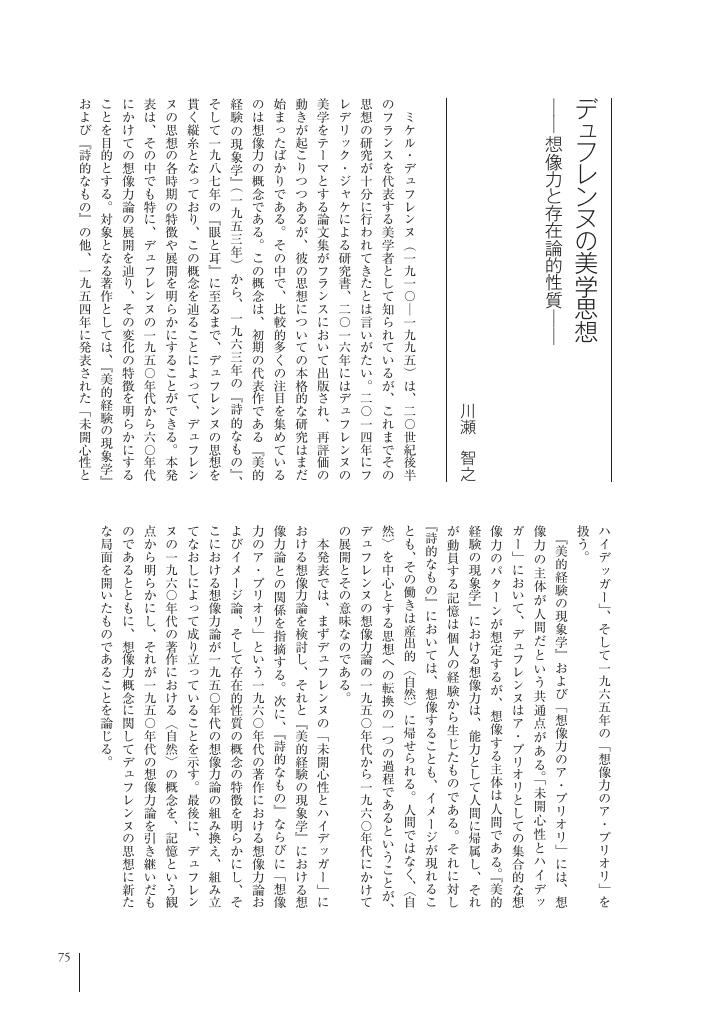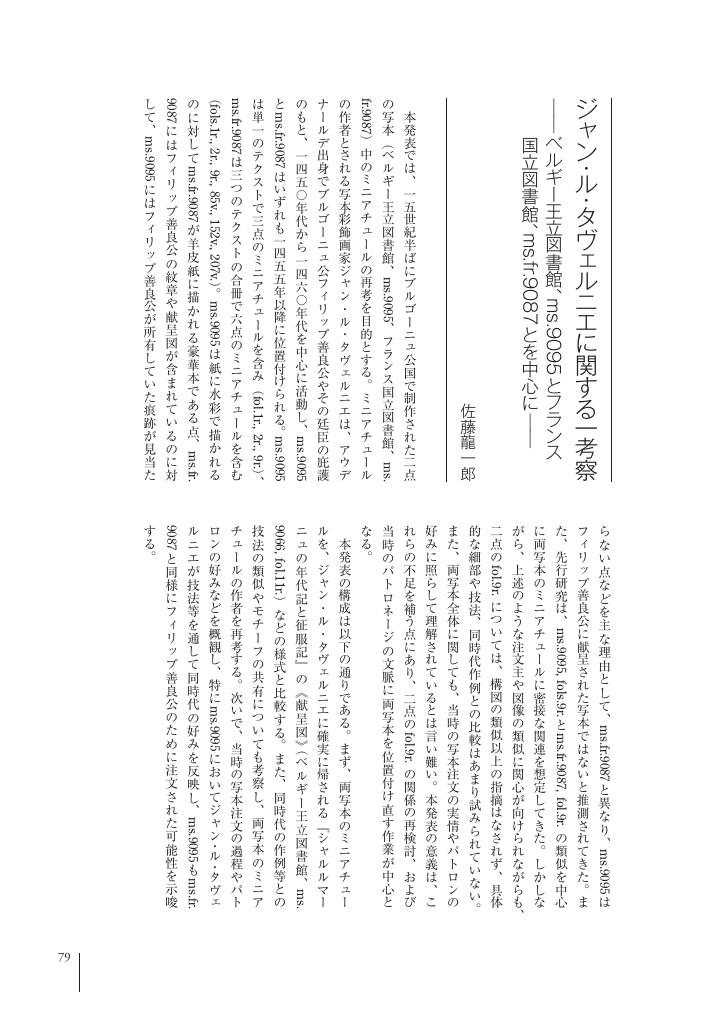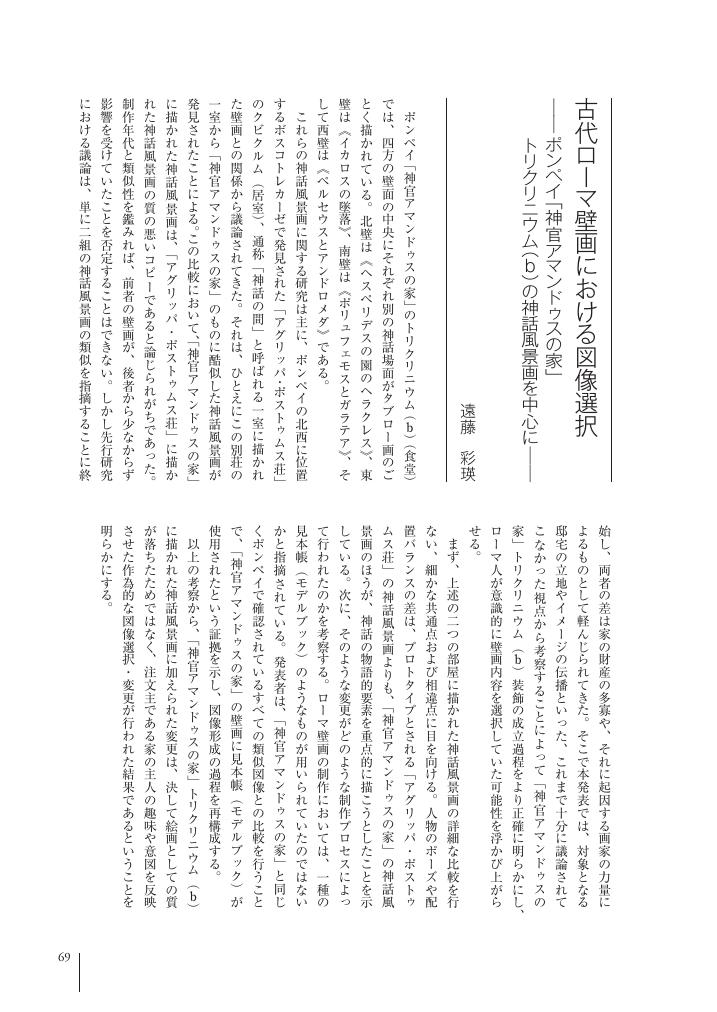1 0 0 0 OA アビ・ヴァールブルクにおける 「メディウム」の問題 一九二七年の「切手講演」に即して
- 著者
- 二宮 望
- 出版者
- 美学会
- 雑誌
- 美学 (ISSN:05200962)
- 巻号頁・発行日
- vol.69, no.2, pp.85, 2018 (Released:2020-03-23)
1 0 0 0 OA クリストのペインテッド・ フォトグラフに関する考察
- 著者
- 日置 瑶子
- 出版者
- 美学会
- 雑誌
- 美学 (ISSN:05200962)
- 巻号頁・発行日
- vol.69, no.2, pp.86, 2018 (Released:2020-03-23)
1 0 0 0 OA ジゼル・ブルレの『音楽的時間』 における「音楽形式」について 記憶と期待の観点からの解釈
- 著者
- 舩木 理悠
- 出版者
- 美学会
- 雑誌
- 美学 (ISSN:05200962)
- 巻号頁・発行日
- vol.69, no.2, pp.87, 2018 (Released:2020-03-23)
- 著者
- 古川 萌
- 出版者
- 美学会
- 雑誌
- 美学 (ISSN:05200962)
- 巻号頁・発行日
- vol.69, no.2, pp.88, 2018 (Released:2020-03-23)
1 0 0 0 OA 戦後イタリアにおける建築と イデオロギー 「一九六八年」におけるアルド・ロッシの言説
- 著者
- 松井 健太
- 出版者
- 美学会
- 雑誌
- 美学 (ISSN:05200962)
- 巻号頁・発行日
- vol.69, no.2, pp.89, 2018 (Released:2020-03-23)
1 0 0 0 OA 形は微動する
- 著者
- 金田 千秋
- 出版者
- 美学会
- 雑誌
- 美学 (ISSN:05200962)
- 巻号頁・発行日
- vol.69, no.2, pp.73, 2018 (Released:2020-03-23)
1 0 0 0 OA 天皇・皇族の身体の可視化/ 不可視化について 大正期から昭和初期の映画を手がかりに
- 著者
- 紙屋 牧子
- 出版者
- 美学会
- 雑誌
- 美学 (ISSN:05200962)
- 巻号頁・発行日
- vol.69, no.2, pp.74, 2018 (Released:2020-03-23)
1 0 0 0 OA デュフレンヌの美学思想 想像力と存在論的性質
- 著者
- 川瀬 智之
- 出版者
- 美学会
- 雑誌
- 美学 (ISSN:05200962)
- 巻号頁・発行日
- vol.69, no.2, pp.75, 2018 (Released:2020-03-23)
1 0 0 0 OA ベルクソンにおける共同性と美 優美論を手がかりにして
- 著者
- 北 夏子
- 出版者
- 美学会
- 雑誌
- 美学 (ISSN:05200962)
- 巻号頁・発行日
- vol.69, no.2, pp.76, 2018 (Released:2020-03-23)
1 0 0 0 OA 東松照明と『日本』(一九六七年) 「群写真」概念の誕生と発展を辿る、 遡及的読解の試み
- 著者
- 北澤 周也
- 出版者
- 美学会
- 雑誌
- 美学 (ISSN:05200962)
- 巻号頁・発行日
- vol.69, no.2, pp.77, 2018 (Released:2020-03-23)
1 0 0 0 OA 音楽のうちに悲しみを聴く
- 著者
- 源河 亨
- 出版者
- 美学会
- 雑誌
- 美学 (ISSN:05200962)
- 巻号頁・発行日
- vol.69, no.2, pp.78, 2018 (Released:2020-03-23)
- 著者
- 佐藤 龍一郎
- 出版者
- 美学会
- 雑誌
- 美学 (ISSN:05200962)
- 巻号頁・発行日
- vol.69, no.2, pp.79, 2018 (Released:2020-03-23)
1 0 0 0 OA ユクスキュルにおける主体概念 「気分(Stimmung)」の観点から
- 著者
- 新松 寛明
- 出版者
- 美学会
- 雑誌
- 美学 (ISSN:05200962)
- 巻号頁・発行日
- vol.69, no.2, pp.80, 2018 (Released:2020-03-23)
1 0 0 0 OA アーニョロ・ブロンヅィーノ作《甲冑姿のコジモ一世の肖像》 (ウフィツィ美術館)再考
- 著者
- 瀬戸 はるか
- 出版者
- 美学会
- 雑誌
- 美学 (ISSN:05200962)
- 巻号頁・発行日
- vol.69, no.2, pp.81, 2018 (Released:2020-03-23)
1 0 0 0 OA デザインと素描 官立デザイン学校における 素描教育の系譜
- 著者
- 竹内 有子
- 出版者
- 美学会
- 雑誌
- 美学 (ISSN:05200962)
- 巻号頁・発行日
- vol.69, no.2, pp.82, 2018 (Released:2020-03-23)
1 0 0 0 OA 映像のなかのスクリーン リアプロジェクションをもちいた多層的映像をめぐって
- 著者
- 大﨑 智史
- 出版者
- 美学会
- 雑誌
- 美学 (ISSN:05200962)
- 巻号頁・発行日
- vol.69, no.2, pp.37, 2018 (Released:2020-03-23)
Rear projection is one of the most frequently used compositing techniques in Hollywood cinema from the 1930s to the late 1960s. Nevertheless, this technique has been hitherto underestimated. Of the scarce existing research, some studies have pointed out the economic advantages of it in terms of the studio system of the day, while others have examined it in the limited context of certain films or film directors. But such approaches have not paid sufficient attention to the fact that the many films had used the technique in spite of harsh criticism regarding the resultant image quality. This paper aims to clarify in part how the images created through rear projection were interpreted by the audiences of the time. The images were surely lacking in terms of the “reality” pursued by classical Hollywood cinema. However, the audiences were able to understand the mechanism of rear projection and experience its effects in a mode separate to that supposed by the classical Hollywood cinema. By analyzing a moving vehicle scene, I demonstrate how the gap created between foreground and background in the images re-arouses wonder in the audience, allowing them to enjoy the medium of cinema as a visceral attraction.
1 0 0 0 OA オズワルド・ヂ・アンドラーヂの 批評基準について 「ブラジル性」を中心に
- 著者
- 居村 匠
- 出版者
- 美学会
- 雑誌
- 美学 (ISSN:05200962)
- 巻号頁・発行日
- vol.69, no.2, pp.67, 2018 (Released:2020-03-23)
1 0 0 0 OA ミニマル・アートにおけるコレクターの役割 ロバート・モリスとジュゼッペ・パンザを中心に
- 著者
- 鵜尾 佳奈
- 出版者
- 美学会
- 雑誌
- 美学 (ISSN:05200962)
- 巻号頁・発行日
- vol.69, no.2, pp.68, 2018 (Released:2020-03-23)
- 著者
- 遠藤 彩瑛
- 出版者
- 美学会
- 雑誌
- 美学 (ISSN:05200962)
- 巻号頁・発行日
- vol.69, no.2, pp.69, 2018 (Released:2020-03-23)
1 0 0 0 OA 高松次郎「複合体」シリーズ そのドローイングとの関連性より
- 著者
- 大澤 慶久
- 出版者
- 美学会
- 雑誌
- 美学 (ISSN:05200962)
- 巻号頁・発行日
- vol.69, no.2, pp.70, 2018 (Released:2020-03-23)


















